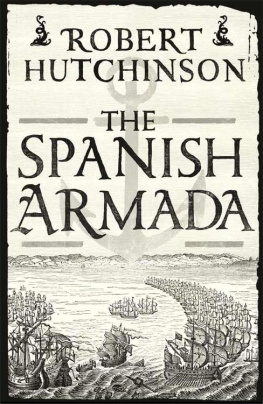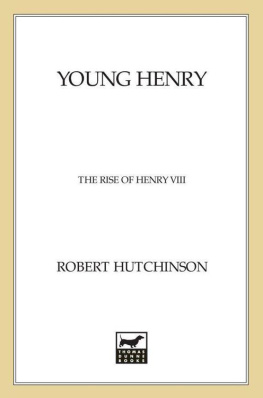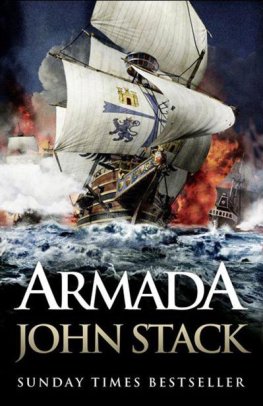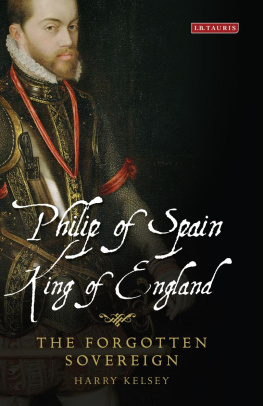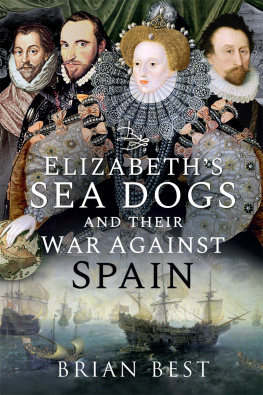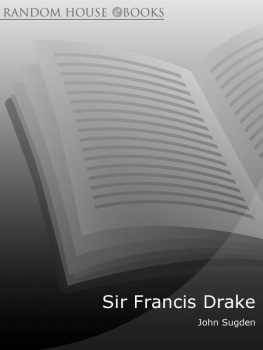THE
SPANISH ARMADA
ROBERT HUTCHINSON
Weidenfeld & Nicolson
LONDON
To Alicia and the young ones:
Marcel, Julian and Giselle,
Alison and Sylvia
CONTENTS
T he Spanish Armada campaign of 1588 changed the course of European history. If the Spanish captain-general Medina Sidonia had managed to successfully escort the Duke of Parmas invasion force across the narrow seas from Flanders, the future of Elizabeth Is government and Protestant England would have looked very black indeed.
It is one of historys greatest what ifs.
If those experienced and battle-hardened Spanish troops had landed near Margate on the Kent coast, it is likely that they would have been in the poorly defended streets of London within a week and the queen and her ministers apprehended. England would have reverted to the Catholic faith and there may have not been a British Empire to come.
Of course, despite his very best efforts, Medina Sidonia failed utterly in his mission and experienced one of the most signal catastrophes in naval annals.
Much has been written about this myth-ridden campaign. This book indeed provides a blow-by-blow account of the naval skirmishes up the English Channel, culminating in the fireship attack off Calais, the Battle of Gravelines and the Armadas subsequent terrible destruction on the west coast of Ireland.
But what is not so well-known is the fact that Elizabeth faced opposition within her own realm to her efforts to defend her crown against the Spanish. There were many who were less than enthusiastic about the coming fight. Some were reluctant to pay for it, or voted with their feet like the gentry shifting their families and moveable wealth away from the coast, rather than standing and fighting. Her ill-trained and ill-armed militia mutinied in the frontline on the Channel coast. The Dorset troops were thought more likely to fight each other than the Spaniards. Patriotism, despite the Tudor propaganda, was not as pervasive as popular perception suggests.
The Armada was the climax to a war of religion, the Catholic Church versus the fledgling Protestant state of England, and Elizabeths Ministers feared that the Catholic majority amongst her subjects would immediately rise up in support of the invaders. There were also English Catholics on board the Spanish ships who hated the English queen as a cruel oppressor of their faith and were sailing joyfully to depose her.
Philip II of Spain, having early on been rudely shunned as a prospective husband by Elizabeth, was spurred to spend enormous sums of money in what he saw as a holy crusade against heretic England. But he also had a more prosaic motivation: despite his protestations, Philip was very conscious of his claim on the crown of England. Thus, the Anglo-Spanish war of the 1580s was a very personal conflict between two monarchs who reviled each other but were frustratingly strapped for cash. The surprising maverick in all this was Pope Sixtus V, who cared more for ducats than devotion, and often expressed an embarrassingly public admiration for the English queen.
The Armada campaign was the first modern conflict as we would understand it. A largely unexplored aspect has been the intense intelligence war fought by both sides, employing many of the espionage techniques familiar today. Black propaganda was also used to vilify each other and sap the morale of their adversaries, in publications that Joseph Goebbels, Hitlers Information Minister almost four centuries later, would have been proud to write and distribute.
Because of the state of Elizabeths exchequer and her natural parsimony, the English ships were starved of gunpowder and ammunition and failed to land the killer blow on the Great and Most Fortunate Navy.
Englands own Protestant God was thought responsible for His divine hand in stopping the Armada. We now suspect it was probably climate change that blew apart Philips flawed plans for the conquest of England.
Much of the source material for this book has been drawn from contemporary documents, where possible employing the written or reported spoken words used by those living at the time.
Throughout, the dates are expressed in the New Style or Gregorian calendar, introduced by Pope Gregory XIII in 1582 and used by most of Western Europe from 1587. England naturally refused to conform and did so for more than another century; their old Julian calendar running ten days behind.
T his book could not have been written without the tireless and enthusiastic support of my dear wife Sally who, appropriately as the daughter of a sea captain, has helped me with the complexities of naval warfare in the sixteenth-century as well as the mysteries and dilemmas of both the English and Spanish orders of battle in the campaign.
A great number of friends and colleagues have very kindly given invaluable support and help in tracking down manuscripts and rare books in Britain and in Europe. As always my particular thanks go to Robin Harcourt Williams for his generous help with the Cecil Papers held in the archives of the Marquis of Salisbury at Hatfield House. I am also very grateful to Heather Rowland, head of library and collections, and Adrian James, assistant librarian, at the Society of Antiquaries at Burlington House, London; Kay Walters and her team at the incomparable library at The Athenum in Pall Mall; the ever-willing staff at the University of Sussex library at Falmer, Sussex and the always helpful teams at The National Archives at Kew and in the Rare Books, Manuscripts and Humanities reading rooms of the British Library at St Pancras.
At Weidenfeld & Nicolson, Alan Samson has, as ever, been very encouraging and helpful, as has Lucinda McNeile, and I would like to record my grateful thanks to my editor Anne OBrien and Douglas Matthews for compiling a complex index. I am also grateful to my agent Andrew Lownie.
As always, any errors or omissions are entirely my own responsibility.
Robert Hutchinson
West Sussex 2013
The law of nature moves me to sorrow for my sister. The burden that is fallen upon me makes me amazed and yet... ordained to obey His appointment, I will thereto yield, desiring from the bottom of my heart that I may have the assistance of His Grace to be the minister of His heavenly will in this office now committed to me.
Elizabeth I, on hearing of her accession to the throne of England. Hatfield, 17 November 1558.
E lizabeth Tudors long years of torment, anxiety and fear finally ended just before noon on 17 November 1558, reputedly beneath the spreading branches of a gnarled old oak tree in the verdant grounds of Hatfield Palace, in Hertfordshire, 20 miles (32.2 km) north of London.
Six senior members of Queen Mary Is Privy Council, accompanied by Sir William Cordell, speaker of the House of Commons, had cantered breathlessly across the greensward to bring her the news she had long dreamt of receiving but in her dark days of despair, feared would never come.
After hastily dismounting, they knelt on the grass before the princess, who had been walking outside in the chill November air, and solemnly informed her of her half-sisters death.
Elizabeth, the twenty-five-year-old red-headed daughter of Anne Boleyn and King Henry VIII, had succeeded at last as Queen of England.
Although the fateful message from London had been expected almost hourly, its import still stunned her. She too fell to her knees and must have breathed a prayer of profound thanks both for her survival and her safe accession. At length, after a good time of respiration, exaltation flooded through her body and she spoke her first
Around seven oclock that morning, Mary had died in St James Palace, London, only moments after the sacred Host had been solemnly elevated during a Mass celebrated in her bedchamber. Drifting in and out of consciousness, she died in great pain from the ovarian cysts or uterine cancer that finally killed her. Death was energetically stalking abroad that day. An epidemic of influenza (or more probably the English Sweating Sickness a form of viral pneumonia), which had carried off up to a fifth of her subjects over the previous two years, still claimed its victims, including Cardinal Reginald Pole, her Archbishop of Canterbury, who succumbed to its fevers within twelve hours of his sovereigns passing.

